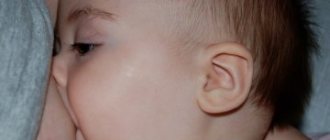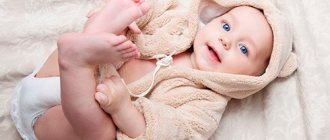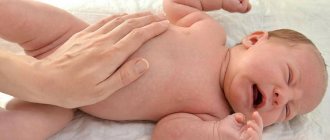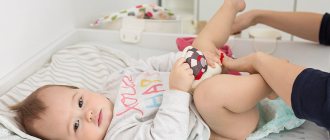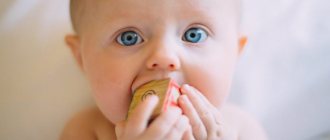What does a normal stool look like?
The child is born with sterile intestines. It contains no harmful or beneficial bacteria. During childbirth and the first time a baby is put to the breast, its intestines are populated with beneficial microorganisms and antibodies to diseases that the mother has suffered.
Distinguishing normal stool from diarrhea in a child under one year old is not an easy task. Especially in breastfed children. The diet of a nursing mother includes a large list of foods; the immature digestive system reacts differently to each of them. The frequency of bowel movements also depends on the woman's diet.
The appearance and frequency of bowel movements changes throughout the first year of life. In the first days after birth, a baby produces meconium - thick, tarry, black or dark green stool.
As breast milk or an adapted formula arrives on the 3rd–4th day of life, the baby's stool becomes yellowish in color, becomes liquid and heterogeneous. It may contain white flakes (curdled milk) and mucus particles. The newborn goes to the toilet during each feeding or after eating. The frequency of bowel movements reaches 10 times a day. It is during this period that parents begin to suspect that the baby has diarrhea. Liquid yellow stool in a newborn is a normal physiological phenomenon. The norm of stool in children depends on the type of food.
Infants
When a child feeds on mother's milk, according to pediatricians, stool can be of any consistency and color. Loose stool in a newborn should not cause concern if it:
- no foam;
- pungent odor;
- splashes of blood;
- a lot of mucus.
The color of stool can be yellow, brown, a green tint is allowed. Too frequent large stools with white flakes indicate that the baby is overfed. The immature intestines do not have time to process a large volume of milk. Excess food is passed out in the feces.
By 2 months, the baby’s intestinal microflora returns to normal. Going to the toilet becomes more predictable. The increase in bowel movements in infants aged 2–5 months is associated with the mother’s diet.
By the 3rd month of life, the baby’s stool acquires a mushy, uniform consistency. The frequency of bowel movements is reduced.
With the introduction of complementary foods, feces gradually become formed and turn brown or green. It may contain particles of fruits and vegetables. This happens if the baby is given unchopped foods. The intestines are not yet mature enough to digest coarse fiber.
Features of stool in artificial babies
In children who are fed with formula, the feces are denser and darker than in infants, and have an unpleasant odor. Watery, light-colored stool is a concern. Liquid, homogeneous yellow stool is the norm for bottle-fed children. Often the shade changes after changing the adapted mixture. The feces of formula-fed babies may turn green due to the presence of iron in the diet.
Liquid stool in a baby with a strong putrid odor is a reason to consult a doctor.
Causes and treatment of diarrhea in an infant
A change in an infant's stool always causes concern among his parents. One of the most common violations of this kind is
Diarrhea in a child: norm and pathology
Diarrhea in a child, or diarrhea (from the Greek diarrheo - “flowing”), is a frequent and profuse bowel movement of liquid fecal matter.
a child actually has , it is necessary to know some physiological characteristics characteristic of infants.
First of all, we emphasize that the frequency of stool and its character in children under 1 year of age differ from those in older age groups and, in addition, change throughout the first year of life.
The stool of a newborn baby in the first 1-2 days after birth has a special name - meconium. This term refers to all the contents of the baby’s intestines that accumulated before birth, before the baby is first put to the breast. Meconium is a thick, viscous mass of dark olive color and odorless. Normally, it goes away within 12-48 hours after the baby is born. Then a transitional stool of a slightly thinner consistency of greenish-yellow color is observed, and from the 5th day of life - normal bowel movements.
The type and quantity of bowel movements in children of the first year of life depend significantly on the nature of their diet. When breastfeeding, feces look like liquid sour cream, golden yellow in color with a sour odor. With artificial feeding, feces are usually thicker, putty-like consistency, light yellow in color, often with an unpleasant odor. The number of bowel movements during the first six months of life in breastfed children reaches 7 times a day, while in “artificial” babies it is 3-4 times a day. In the second half of life, the number of bowel movements gradually decreases to 3-4 with natural feeding and to 1-2 with formula feeding. At the same time, the consistency of feces becomes increasingly thick, and the color and smell largely depend on the nature of the complementary food received.
It should be noted that during the first year of life, especially in the first few months after birth, the baby may pass stool reflexively during sucking, which is the absolute norm.
Pathological loose stools in an infant can be suspected when the frequency of bowel movements increases above the physiological norm, a change in the normal consistency and color of feces, and the appearance of pathological impurities in the stool, such as mucus, pus, and blood.
Diarrhea in a child is considered acute if it occurs unexpectedly and stops within 1-2 weeks. Chronic diarrhea lasts more than 2 weeks.
mechanisms for the development of diarrhea in children . In some cases, food passes through the intestines too quickly due to increased peristalsis - wave-like contraction of the walls. In others, an increase in the volume of feces occurs due to impaired absorption in the large intestine of water and electrolytes - substances that, in solution, partially or completely consist of charged particles - ions. Diarrhea in a child can also begin due to pathologically increased secretion of fluid into the intestinal lumen.
The frequent occurrence of digestive disorders, including diarrhea, in infants is due to:
- immaturity of the digestive system, which is manifested by insufficient production and low activity of digestive enzymes;
- low compensatory capabilities of the electrolyte transport system through the intestinal wall;
- immaturity of the immune system of the mucous membranes;
- weak barrier function of the intestine, which consists in preventing the penetration of harmful substances, allergens, pathogens, etc. through the intestinal wall into the internal environment of the body.
Diarrhea in a child: causes
Features of baby food. Nutritional or nutritional factors are a common cause of diarrhea in infants . Diarrhea occurs when the child’s immature digestive system is overloaded with an increased amount of food, an excessive amount of incoming nutrients, or their disproportionate ratio in the baby’s diet.
In breastfed children, intestinal disorders, including diarrhea, are often caused by the following foods consumed by the nursing mother:
- smoked meats, sausages, sausages;
- ketchups, mayonnaise;
- carbonated sweet drinks;
- products containing preservatives;
- rich meat or fish broths;
- refined carbohydrates - cakes, chocolate, semolina;
- whole cow's milk, especially when consumed in quantities over 500 ml per day;
- some vegetables (cabbage, cucumbers, tomatoes, legumes) and fruits, such as grapes;
- highly allergenic foods: strawberries, raspberries, citrus fruits, chocolate, caviar, red fish, seafood.
Another reason is that the child receives too much food that is not appropriate for his age. A serious violation is feeding an infant with the milk of domestic animals, which is very different in composition from mother's milk and causes a disproportionate intake of many nutritional components into the child's body. Disproportion also occurs when the rules for diluting milk formula are violated, or when a baby is fed a formula that is not appropriate for his age and health status.
The cause of diarrhea in a child can be even minimal changes in diet: switching to a new milk formula, drinking water with a different composition - for example, when changing the region of residence. Another common reason is complementary feeding products that are not appropriate for the child’s age and a violation of the basic rules for their introduction - gradualness, consistency, etc. It should be remembered that diarrhea in a child can be the equivalent of an allergic reaction to foods, such as fish, chicken eggs, etc. and indicate food intolerance.
Usually, diarrhea in a child due to a short-term interruption in feeding the baby does not lead to serious consequences and is quickly cured when the causes are eliminated.
Lactase deficiency . This condition develops as a result of a decrease or complete absence of the lactase enzyme in the small intestine. There is a distinction between primary lactase deficiency, associated with congenital enzymatic deficiency, and secondary, which develops as a result of damage to the cells of the intestinal mucosa against the background of infectious and allergic inflammation, atrophy, or thinning, of the mucous membrane.
Clinical symptoms of primary lactase deficiency are flatulence, colic, diarrhea, restlessness of the baby during feeding and immediately after it. They usually appear in a child at 3-6 weeks of life, which is apparently associated with an increase in the volume of milk or formula consumed. Stools with lactase deficiency are watery, foamy, may have a greenish tint, and have a sour odor. An important symptom is low weight gain or even weight loss.
In secondary lactase deficiency, the stool is often green and contains mucus and undigested food.
Lactase deficiency can be confirmed by taking tests. In any case, if you discover the above symptoms, you must contact your pediatrician, who, after examination, will prescribe adequate therapy. It is important to understand that lactase deficiency is not a reason to refuse breastfeeding or switch to mixed feeding. Moreover, with age, as the digestive system matures, manifestations of lactase deficiency often disappear. For children who are bottle-fed, there are special medicinal milk formulas.
Infections. Acute intestinal infection is provoked by pathogenic bacteria, viruses, and protozoa. Foodborne illness differs from acute intestinal infection in that the disease is caused not by the bacteria themselves, but by their toxins. The entry of pathogens and their metabolic products into the child’s body occurs when the rules of hygiene and care for the baby are not followed, when the basic rules of hygiene of the mother and other persons in contact with the child are violated, when eating low-quality products, for example, baby food with an expired expiration date or for a long time stored after opening the package. Also, a common cause of diarrhea in infants and young children is a viral infection - rotavirus, adenovirus, etc., which is transmitted by airborne droplets when visiting crowded places, as well as when someone in the household becomes ill.
The main manifestations of intestinal infections are vomiting, diarrhea in a child , increased body temperature (this does not always happen), and abdominal pain. Weakness, lethargy, loss of appetite may occur, and in some cases a rash appears on the body. The most serious complication of intestinal infections is dehydration due to loss of fluid and electrolytes.
The nature of diarrhea in children with intestinal infections can be different. Watery diarrhea, which is also called secretory, is caused by pathogens such as rotavirus, salmonella, enteropathogenic Escherichia coli, Vibrio cholerae, etc. It is characterized by damage to the transport system of water and electrolytes in the intestinal wall, as a result of which the liquid is not only not absorbed into the blood, but, on the contrary, it is released, or secreted, into the intestinal lumen. Watery diarrhea is characterized by frequent, profuse, watery stools, often with greens.
With invasive, “bloody” diarrhea, pathogens penetrate the intestinal mucosa and destroy the cells lining it. In this case, there is a frequent and painful urge to defecate, the stool is often passed in a small volume and contains mucus and blood. The causative agents for such diarrhea in children can be Shigella, which causes dysentery, salmonella, enteroinvasive E. coli, etc.
Intestinal dysbiosis. In its extreme manifestations, this condition is also accompanied by diarrhea. Of particular note here is diarrhea that occurs while taking broad-spectrum antibacterial drugs, when not only pathogenic microorganisms are destroyed, but also a significant part of the normal intestinal microflora and replaced by anaerobic bacteria. In this case, diarrhea in a child is manifested by frequent and copious watery stools with the development of dehydration and intoxication of the body - a painful condition caused by the effect of microbial poisons - toxins - on the body. In this case, immediate discontinuation of the causative drug and administration of appropriate treatment are required. To prevent intestinal dysbiosis while taking antibiotics, drugs are used to normalize the intestinal microflora (pre- and probiotics) in parallel with and after antibacterial therapy.
Diarrhea in a child can be a side effect of certain medications. Here is a far from complete list of medications, the prescription of which can cause stool liquefaction: antibiotics, choleretic, antacid drugs, non-steroidal anti-inflammatory drugs, etc. The occurrence of loose stools while taking medications should be a reason to consult a doctor with possible discontinuation of the causative drug.
Diarrhea in a child. How to treat
The occurrence of diarrhea in infants requires immediate consultation with a doctor.
In cases where, in addition to diarrhea, the child has an increase in body temperature above 38°C, severe weakness, drowsiness; if phenomena of dehydration of the body are observed - dry lips and tongue, pointed facial features, “sunken” eyeballs, sagging skin; If the child stops urinating, immediate hospitalization of the baby in a hospital is indicated, where an ambulance will take you.
If it is impossible to quickly obtain qualified medical care - at the dacha, on the road, etc. - first of all, it is necessary to take measures to prevent dehydration of the body, which in infancy with diarrhea can develop very quickly and cause shock and death of the child. Rehydration, or fluid replenishment, is best done with standard saline solutions GASTROLIT, ORALIT, REHYDRON, which it is advisable to always have in your home medicine cabinet. If ready-made medications are not available, you can prepare a rehydration solution yourself. To do this, dissolve 1–2 tbsp in 1 liter of drinking water. spoons of sugar, 1?/?2 teaspoons of salt and 1?/?2 teaspoons of baking soda.
If a child’s diarrhea has recently begun and signs of dehydration have not yet developed, saline solutions are given to the child at the rate of 10 ml/? kg of body weight after each episode of loose stools or vomiting. If symptoms of dehydration are already evident, the amount of fluid administered is increased to 50–100 ml/kg for 6 hours, followed by fluid replacement at the rate of 10 ml/kg of body weight after each episode of loose stools or vomiting. It should be remembered that feeding the baby should be carried out in minimal portions of solutions (1 teaspoon - 1 tablespoon every 10-15 minutes), since a larger volume of liquid administered simultaneously can provoke vomiting.
If the body temperature rises above 38.5°C, the child must be given an antipyretic drug based on PARACETAMOL - PANADOL, CALPOL, EFFERALGAN - by mouth. The use of suppositories is not advisable, given the frequent loose stools. If the child has had seizures in the past, if he suffers from chronic or congenital diseases of the cardiovascular and pulmonary systems, or if the baby is under 3 months old, an antipyretic should be given already at a temperature of 38 ° C.
To remove toxins from the gastrointestinal tract and consolidate stool, the baby is given sorbents - SMEKTU, NEOSMEKTIN, DIOSMEKTID. One sachet of the drug (3 g) is dissolved in 50 ml of drinking water and given to the baby in small portions throughout the day.
It should also be noted that a child with diarrhea should be washed after each bowel movement to avoid skin irritation.
Diarrhea symptoms
Diarrhea in an infant is determined by the following signs:
- watery, slightly colored consistency;
- change in the smell of stool;
- the volume of feces has increased;
- frequency more than 10 times a day (in children from 3 months);
- restless behavior, crying;
- lethargy.
A child of 6-7 months begins to cut his first teeth. This process is often accompanied by frequent bowel movements, copious amounts of saliva, and reddening of the gums. Stool disorder is explained by the fact that during teething, babies pull various objects into their mouths.
Inflammation of the intestinal mucosa is accompanied by watery contents of the diaper with fragments of mucus and blood. Green diarrhea during breastfeeding is normal. If stools of this color are accompanied by vomiting and fever, they indicate an intestinal infection. Watery, foamy discharge indicates increased proliferation of Staphylococcus aureus.
If your baby is happy, gaining weight, drinking and eating well, loose stools should not be a concern.
Intestinal infections
A change in the normal state of a 2-month-old baby may be caused by a medical condition. Parents should be alert if:
- the child constantly cries hysterically, refuses food, twists his legs, pulling them towards his tummy;
- there is an increase in bowel movements - more than 10 times a day;
- the appearance of stool has changed - watery consistency, the presence of bloody streaks, pus, mucus impurities;
- Strong smell;
- feces splash out with a loud bang;
- the skin around the anus is hyperemic, swollen, and covered with a rash;
This may be accompanied by fever, nausea, and vomiting. The child cries from abdominal pain and suddenly loses weight.
The cause of this condition is infection. The most common infection in babies 2 months of age is rotavirus.
Causes of diarrhea in infants
Intestinal upset can be caused by any disease. Causes of diarrhea in newborns and infants:
- intestinal infection;
- ARVI;
- bronchitis;
- otitis;
- taking antipyretic drugs, antibiotics;
- dysbacteriosis;
- overfeeding;
- congenital pathologies of the gastrointestinal tract;
- introduction of complementary foods;
- teething;
- food poisoning;
- intolerance to certain foods;
- allergy;
- deficiency of enzymes for digesting food;
- difficulty absorbing incoming substances;
- change of climate zone;
- giardiasis;
- stress.
During childbirth or while in the hospital, the baby may contract an infection (most often Staphylococcus aureus), which causes watery stools with mucus.
In a one-month-old baby, stool upset most often occurs due to indigestion. The intestinal microflora has not yet formed; it is regularly populated by new microorganisms. Any malfunction in the gastrointestinal tract can provoke dysbacteriosis and, as a result, diarrhea.
The cause of diarrhea in a newborn and infant during natural feeding can be the mother’s poor nutrition.
A common cause of diarrhea in children 2,3,4 months old is an unsuitable adapted formula, switching from breast milk to artificial feeding.
In what cases is emergency help needed?
You should consult a pediatrician in any case if your baby has loose stools. For children under one year old, dehydration is very dangerous. Emergency medical care is required in the following cases:
- frequent and foamy stools with a pungent odor;
- blood in stool;
- body temperature above 38 degrees;
- vomiting with bile (more than 3 times);
- a large amount of mucus in the stool;
- rash on the body.
You can tell that a baby is dehydrated by the following symptoms:
- crying without tears (this sign does not apply to children under 3 months);
- confluence of the fontanel;
- lack of urination for more than 8 hours;
- lethargy;
- dry lips.
What can diarrhea in a baby indicate?
Diarrhea may be accompanied by moodiness
We must learn to distinguish normal stool from any pathological changes. A timely reaction of parents to changes can save the health and even the life of the child. After all, failures can be evidence of serious illnesses. And simply diarrhea, which is a consequence of a disease, for example, a common acute respiratory viral infection, can quickly lead to dehydration.
What should you pay attention to?
If your baby has loose stools accompanied by vomiting, you should immediately call an ambulance. The following are cases when you should not delay calling an ambulance in case of diarrhea in a newborn:
- the child is not a year old, much less 6 months old, and has developed diarrhea (more than 3–5 cases);
- temperature above 38° C;
- the baby vomited more than 3 times;
- the child has signs of dehydration: sunken fontanel, no tears when crying, dry lips, sunken eye sockets.
You should contact your local doctor if you have the following signs of disturbances:
- mucus, foam in stool;
- a lot of gases coming out during defecation;
- diarrhea occurs often, because of this the baby is weak and does not gain weight;
- streaks of blood are noticeable in the stool;
- a rash appeared in the abdomen, on the cheeks, on the elbows and legs; the rashes have a rough surface;
- diarrhea developed after taking acetylsalicylic acid with an increase in temperature due to ARVI,
- even if several days have passed;
- diarrhea began after treatment with antibiotics for other diseases.
What to do if a newborn has loose stools
If diarrhea is accompanied by fever, the child is often put to the breast and an ambulance is called. The artificial drink is topped up with water from a spoon. To prevent electrolyte imbalance, the baby is given a saline solution:
- Naturalay;
- Hydrolyte;
- Pedilight.
These products are available in powder form. They should definitely be in your home medicine cabinet.
The popular product Regidron is not suitable for babies under one year old. It has a high concentration of salts.
The daily norm of electrolytes for diarrhea is 100 ml per 1 kg of weight. If the baby does not drink from a spoon, the solution is poured behind the cheek using a syringe without a needle. If there is frequent vomiting and diarrhea, before the doctor arrives, the child should be given rehydrants every 5 minutes, a few milliliters. This will be a home replacement for a saline drip.
Dehydration threatens the baby’s life, so treatment is carried out in a hospital setting. The child is given intravenous electrolytes. If the cause of diarrhea is infection, a course of intramuscular antibiotics is prescribed.
When the baby eats well, does not cry and does not pull his legs towards his tummy, watery bowel movements are not a cause for concern. If you have any suspicions or concerns about loose stools in a breastfed child, you can submit a stool test (coprogram) to the laboratory. The study determines the state of the intestinal microflora, the presence or absence of inflammation and infection.
Vomiting and diarrhea in an infant with streaks of mucus and blood indicates congenital lactose intolerance. In this case, an allergen test is taken. Loose stools and vomiting with this problem are provoked not only by the formula, but also by breast milk if the mother consumed foods containing lactose. These include milk, kefir, cottage cheese, cheese, yogurt, and beef. A properly selected plant-based mixture or a revision of the nursing mother’s menu can solve the problem.
Signs and treatment of dehydration in an infant with diarrhea
You can determine if your baby is dehydrated by the following signs:
- faint cry;
- moodiness;
- the child cries, but there are no tears;
- loose skin;
- sunken eyes;
- dry mucous membranes;
- low pressure;
- pointed nose;
- apathy;
- sunken fontanel;
- decreased number of urinations;
- tachycardia.
If the above described signs are detected, you should immediately call an ambulance. Until doctors arrive, the child must be given plenty of fluids. If there are rehydration products (Pedilite, Naturallay, Gidrovit, Humana Electrolyte, Oralit), they can also be used.
First aid for diarrhea in infants
Emergency measures for children older than 1 month include giving the child a solution of electrolytes or chamomile decoction. The liquid is given regularly, in small portions.
Rehydrants are prepared strictly according to the instructions. A solution that is too concentrated may increase vomiting and diarrhea.
After 6 months, a baby can be given dried fruit compote. Breastfed babies are often offered the breast. You need to give your baby water in any case, even if you have to force yourself to do it.
Diarrhea without fever in breastfed babies under 6 months is often associated with the mother's diet. In this case, diarrhea can be stopped by adjusting the woman’s diet. Laxative foods are excluded from the menu: beets, kefir. The cause of diarrhea in a baby may be fatty, fried foods with a lot of preservatives, which the mother ate.
Diarrhea after the introduction of complementary foods indicates that the body is not yet ready for this product. The baby is not given new food until the consistency of the stool improves. After 5–7 days, complementary feeding is resumed starting with a teaspoon of puree. The sudden introduction of complementary foods and a variety of foods cause intestinal upset.
In a child aged 7–10 months, diarrhea is usually associated with teething. If the intestinal disorder is not complicated by an increase in temperature, diarrhea is stopped by adjusting the infant's diet. Avoid foods with a laxative effect for a while:
- prunes;
- dried apricots;
- pumpkin;
- fresh kefir.
The baby is given rice porridge and crackers. A cold compress is applied to the gums and a cooling gel is used.
Diarrhea is a reason to exclude juices from your baby’s diet. The sugar they contain is poorly absorbed by the intestines, which leads to watery stools.
Treatment of diarrhea in infants
The main remedy for treating diarrhea not complicated by infection is saline solution. It is impossible to stop diarrhea at this age; you can only prevent its consequences. Sometimes treatment is carried out with absorbent agents:
- Smecta;
- Polysorb;
- Novosmectin.
They are not absorbed into the blood and are excreted from the body through feces. Once in the intestines, absorbents bind and remove toxins, viruses and bacteria.
Viral and bacterial infections with high fever are treated with antibiotics: Amoxicillin, Augmentin, Levomycetin.
For chronic diarrhea caused by dysbacteriosis, medications that normalize the intestinal microflora are prescribed:
- Bifidumbacterin;
- Linux;
- Acipol;
- Hilak-Forte.
These drugs also help cope with diarrhea after taking antibacterial drugs.
Recommendations for eliminating chronic diarrhea
To improve your baby's bowel movements, you should not stop breastfeeding. Switching to an adapted mixture will only worsen the problem. Advice from pediatricians that is relevant for chronic diarrhea in infants:
- feed the baby regularly to prevent weakening of the body;
- if the child is breastfed, food intake is carried out on demand, and not by the hour;
- do not introduce new foods into the diet until stool is restored;
- follow the diet of a nursing mother.
Changes in the consistency of stool and anxiety in a bottle-fed baby are often due to the fact that the chosen formula is not suitable for him. Changing the diet can solve the problem with stool and save the child from colic.
To prevent diarrhea, it is important to follow the rules for preparing the mixture and wash toys regularly. Infants are less susceptible to intestinal infections, since mother's milk protects the child from viruses and bacteria. A nursing woman needs to follow a diet so as not to cause bowel upset in the baby and monitor the reaction to newly introduced foods.
We recommend: How to take black peppercorns for diarrhea?
Useful video
Source
Parents are concerned about their newborn's stool. Liquid stool is not a disease, so there is no need to worry in advance. Diarrhea in a baby can be either normal or indicate some kind of disorder in the digestive system. Before you begin to take a number of therapeutic measures, it is worth understanding the physiological characteristics of infants.
